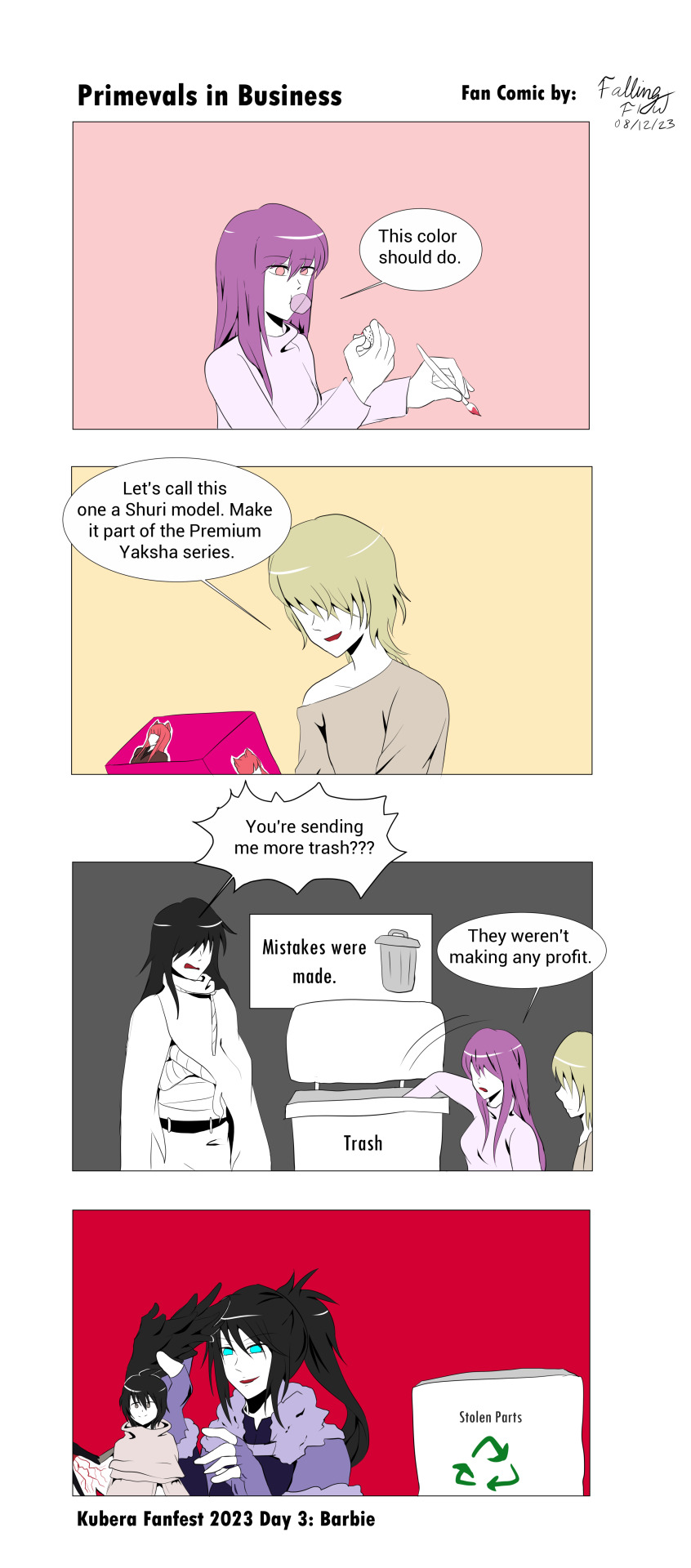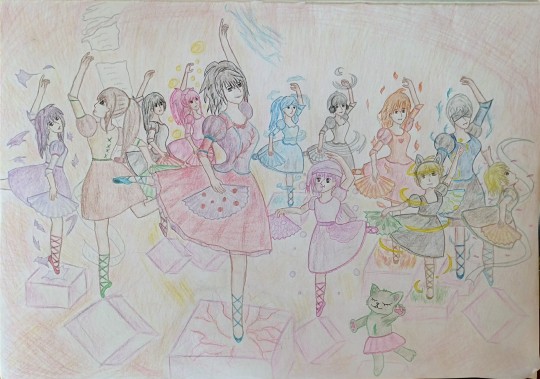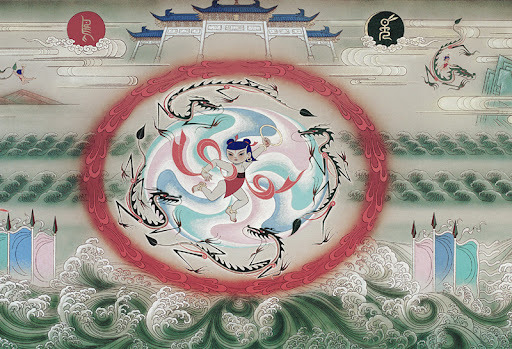#visnu
Text
Lord Vishnu sleeping on Serpent Adishesh Naag
#vishnuji#mahadev#vishnu#laxminarayan#adishesh#vishnubhagwan#lordvishnu#bhagwanvishnu#hanumanchalisa#vishnulakshmi#lakshminarayana#lakshminarayantemple#godvishnu#narayana#lakshminarayan#krishna#lordkrishna#lakshmi#god#narayan#laxminarayantemple#mahabharat#laxmimata#matalakshmi#visnu#ram#matalaxmi#hinduism#jaishreeram#shiv
25 notes
·
View notes
Photo


Visnu your April fool's joke went a little too far….
...
…and you better be ready for the consequences because Asha took that personally!
#one last god kubera#kubera#Asha Rahiro#visnu#my art#ah April Fools' Day the one day of the year Asha wins…. not!#쿠베라
26 notes
·
View notes
Text

citradhātu — valuable minerals like gold, silver, copper etc; vicitra— full of variegatedness; adrīn — hills and mountains; ibhabhagna— broken by the giant elephants;bhuja — branches; drumān — trees; jalāśayān-śiva — health-giving; jalān — reservoirs of water;nalinīḥ — lotus flowers; sura-sevitāḥ — aspired to by the denizens of heaven; citrasvanaiḥ— pleasing to the heart; patra-rathaiḥ — by the birds; vibhramat— bewildering; bhramara-śriyaḥ — decorated by drones.
Translation
I passed through hills and mountains full of reservoirs of various minerals like gold, silver and copper, and through tracts of land with reservoirs of water filled with beautiful lotus flowers, fit for the denizens of heaven, decorated with bewildered bees and singing birds.
Śrīmad-Bhāgavatam 1.6.12
#srilaprabhupada#harekrsna#iskcon#srimadbhagavatam#illustration#art#flowers#forest#soul#beauty#nature#spiritual#light#Visnu#Kṛṣṇa#love#devotion
4 notes
·
View notes
Text

Kubera Fanfest Day 3: Barbie
Primevals in Business
#kuberafest 2023 day 3#kubera#my art#fan art#kuberafest#Kali#Visnu#Brahma#Shiva#What even is Shiva's skin color idk#More on just dolls actually
16 notes
·
View notes
Text

Kali in the 12 Dancing Goddesses by adsagsona
"This is how I imagine the beginning of the universe."
#kubera#one last god kubera#kuberafest 2023 day 3#kali#brahma#indra#agni#vayu#varuna#surya#yama#chandra#shiva#visnu
12 notes
·
View notes
Text








El simbolismo de la Naturaleza: Caracola
Por su forma, la caracola está estrechamente relacionada con la espiral, que parece desenvolverse a partir de un centro y es símbolo del transcurrir del tiempo y de su carácter cíclico.
En el hinduismo, el dios Visnú o Vishnu forma parte de una trinidad llamada trimurti (las tres formas), junto con Brahma y Shiva. Mientras los dos primeros personifican la creación y la destrucción respectivamente, Visnú personifica la preservación. Según algunas tradiciones, Visnú se dividió en tres partes para crear el universo, surgiendo la trimurti de él.
Se cree que Vinsú se presenta en la tierra con diferentes formas o avatares para restaurar el dharma, u orden cósmico. El avatar kurma se trata de Visnú como una tortuga. En cada una de sus extremidades sostiene ciertos elementos de su iconografía: la gadha (mazo divino), el padma (loto), el chakra (disco giratorio de protección) y el vástago (caracola). La caracola simboliza el sonido del universo, el Om, y es el llamado a despertar de la ignorancia.
En el budismo, el sonido de la caracola es la voz de Buda.
En el arte mesoamericano, el caracol representa el agua y se relaciona con algunas deidades como Tláloc, dios del agua y la fertilidad. Las almenas eran elementos ornamentales situados en la parte más alta de los edificios; los templos de Tláloc tenían almenas con forma de caracola.
En diferentes culturas, podemos encontrar la caracola como símbolo y emblema de distintas deidades marinas.
www.tarotdeana.tumblr.com
Imágenes:
"Sesha Naryana" por Raja Ravi Varma y Prensa Ravi Varma, 1920.
"Kurma Avatar" por Raja Ravi Varma, 1920.
Almena caracol, 1325 - 1521.
"Juno pide a Eolo liberar a los vientos" por François Boucher, 1769.
Lee mitos coreanos aquí.
Lee mitos griegos aquí.
Lee mitos japoneses aquí.
#tarot#cartomancia#tarot reading#ocultismo#ocultista#tarot cards#witchcraft#brujería#artes ocultas#cosas de brujas#simbolismo#simbología#hinduism#hinduismo#budismo#buddhism#conch#caracola#sea#símbolos#symbolism#avatar#vishnu#visnu
0 notes
Video
youtube
1,000 Names of Vishnu | Vishnu Sahasranama Stotram | Gaiea Sanskrit
0 notes
Text
Ow
youtube
#God Emperor#jesus christ#Krishna#Hermes#Hermetica#Hermeticism#Hermetic#Shaddai#El#Visnu#Kingdom keys#Youtube#Messiah
0 notes
Video
Vishnu by Patrick Patrikios (Free No Copyright)
0 notes
Text

Representation of Visnu as Vishvarupa, a theophany whose body represents the structure and form of the entire cosmos.
The different domains of Hell are represented by the legs and feet, with the Earthly and harmonious Heavenly realms represented by the upper stomach and chest, arms, and head; the navel represents the Unmanifest realm that is connected with pure sound and vibration, and absolute silence, which connects everything together.
Though there are multiple Vishvarupa theophanies, the most celebrated is in the Bhagavad Gita, given by Krishna in the epic Mahabharata, where Vishvarupa is considered the supreme form of Vishnu, and the whole universe is expounded as contained within him.
0 notes
Text
Rise and shine!
youtube
Quit pickin fights, pansies.
youtube
0 notes
Text
Lord Vishnu is the ultimate power of the multiverses
#Lord Vishnu is the ultimate power of the multiverses#vishnuji#vishnu#laxminarayan#vishnubhagwan#lordvishnu#bhagwanvishnu#hanumanchalisa#vishnulakshmi#lakshminarayana#lakshminarayantemple#godvishnu#narayana#lakshminarayan#krishna#lordkrishna#lakshmi#god#narayan#laxminarayantemple#mahabharat#laxmimata#matalakshmi#visnu#ram#matalaxmi#hinduism#jaishreeram#shiv#lordvenkateshwara
8 notes
·
View notes
Text
Rudra (Siva) & Vishnu. They’re mentioned in the Vedas, but are they Vedic? Or are they local deities that are made Vedic?
Or are they Vedic but adopted/synthesized by locals?
#hinduism#vaishnavism#shaivism#siva#visnu#vishnu#shiva#religion#hindu#spirituality#india#indus valley#melakam#meluhha
0 notes
Text


0 notes
Text
The Inconsistency of Nezha's Age, a Short Introduction.
Put very bluntly, Nezha’s age varies greatly depending on which story you’re reading and who’s retold it. He is not always a child or an adult depending on retelling, though my intention here is to highlight the sheer variety available first and foremost - and perhaps shine a light on the Indian dieties which may have influenced him. If these varied images are unwanted, please keep scrolling.

I happened to stumble upon a timeline error where Nezha’s brother Muzha is described to be using martial arts weapons referred to as “Hooks of Wu” which were specific to the 1800s, quite a long time after Canonization of the Gods was published, but also originating from a time period where numerous varied editions of that story were in circulation. Upwards of twenty different versions exclusive to the 19th century, actually.
The problem arises that Canonization of the Gods is meant to be occurring during the Zhou Shang conflict, that I will generously assume to be in 1045BCE, centuries before the Hooks of Wu would actually exist. It’s completely possible that the version Gu Zhizhong translated was one of these later editions as is makes no chronological sense for Muzha to have those kinds of weapons to begin with. So I have been on somewhat of a rabbit chase trying to pin down the edition Gu Zhizhong used.
Bearing such errors in mind, it’s easy to see where the confusion of Nezha’s age can come from. Before his origin story was integrated within Canonization of the Gods he would be roughly three to seven days old when his conflict with Ao Guang and the Lady Rock Demoness would occur - whereas within Canonization of the Gods he’s actually 6 or 7 years old.
Outside of that, a definitive age isn’t actually provided. Genuinely, within the scope of Chinese folklore and mythos it’s very rare to assign someone an exact age - which I do believe contributed heavily to the known discourse surrounding Nezha’s age to begin with.
He was imported as an adult from India, a child form not seeming to exist for a while until stories of Krsna were integrated to how the Chinese envisioned Nalakubara. Krsna, being an infantile disguise for the notorious Vishnu, also displays supernatural human strength and is actually successful in killing his father figure (1) — unlike Nezha.
As children, both Krsna and Nezha are able to wield heavenly bows and subjugate water spirits (2) while also being known to be dragon tamers (3). The inclusion of these stories to Nezha predates the sculpting of the Quanzhou Pagoda’s (which have been discussed briefly here) and are arguably the earliest evidence of Nezha being a dragon tamer.
Speculatively a child god combination of both Nalakubara and Krsna named Nana is likely where a majority of Nezha’s child attributes come from, based in the Scripture of the Supreme Secrets of Nana Deva - which would see translations within China during the Northern Song period of 960AD-1127AD. Nana would be described thus:
At that time there was a Deva called Nana. His appearance was exceptionally handsome, and his face beamed with a gentle smile. He was holding the sun, the moon, and various weapons. His numerous treasures and abundant jewelry shone more brightly than the sun and the moon. He made himself a luoye robe (4) from the dragons Nanda and Upananda, and a belt from the dragon Taksaka (5). He possessed the same strength as Narayana (i.e. Visnu). He too came to the assembly and sat down facing the Buddha … At that time the Buddha emanated great light from his dharma body of meditation. The light covered the entire Buddha Universe, reaching all the great evil yaksas, the various types of raksasas and pisacas (6) and all the evil dragons as far as the heavenly constellations. When the Buddhas light shone upon them they all awoke to the truth. The Buddhas light returned to him and, after encircling him three times, entered his head. It then reissued in seven colors from his brow, entering Nana-Deva’s head. When the Buddha light penetrated his head, Nana Deva displayed an enormous body like Mt. Sumeru. His facial expression alternated between terrifying anger and a broad smile. He had a thousand arms, and he was holding a skull (7) and numerous weapons. He was handsomely adorned with a tiger skin robe and skulls. [Mightily Strong] He emanated blazing light and terrifying strength. When Nana Deva displayed this divine body, the great earth shook, and all who beheld him were terrified.
Both Nana and Nezha share the same residence of Vaisravana’s palace, are known dragon tamers, and both were known to use belts. The Supreme Secrets of Nana Deva predate all known connections between Nezha and dragons, perhaps lending to Nezha many more elements than initially believed.
Though without concrete evidence stating one way or another, I can only present this information speculatively - especially as it seems difficult for some to understand that Nezha does enjoy a known adult and child form. This answer has already become quite long, so if there’s still confusion regarding this please feel free to ask for more details.
Bibliography:
(1) Goldman, “Fathers, Sons and Gurus,” pp.350, 364; Masson, “Childhood of Krsna”; Ramanujan, “The Indian ‘Oedipus’”; Silk, Riven by Lust, pp. 164-170.
(2) Harley, “Krishna’s Cosmic Victories”; Matchett, “Taming of Kaliya”.
(3) It’s worth comparing Matchett’s “Taming of Kaliya” p.116 with Canonization of the Gods 12.103. Nezha is five days old within the Ming era Sanjiao yuanliu shengdi fozu sou shen daquan, p. 326.
(4) Luoye is the Chinese term for a garment Indian men tied under the armpit, leaving their right shoulder bare. See Xuanzang, Da Tang Xiyu ji, T. 2087, 51: 876b, and Li Rongxi’s translation, Great Tang Dynasty Record, p.53.
(5) Nanda, Upananda, and Taksaka appear in various Buddhist lists of the eight dragon kings; see Foguang da cidian, pp. 6378,6405.
(6) The rakasas and pisacas are two types of Hindu ogres, who Buddhists demonology incorporated. Both types feed on human flesh. See Foguang da cidian, pp6673-6674 and 3851; Monier-Williams, A Sanskrit-English dictionary, pp. 871 and 628; and Strickman’s survey of Buddhist demonology in his Chinese Magical Medicine, pp. 62-68.
(7) Geboluo appears frequently within the contemporaneous Chinese translation of the Hevajra Tantra (Foshuo dabeikong zhi jin’guang dajiaowang yigui jing), no. 892 volume 18: 587-601.
(8) Zuishang mimi Nana tian jing, no. 1288, 21:358b-c. hi
#nezha#li nezha#lmk nezha#monkie kid nezha#the legend of nezha#nezha 2019#nezha reborn#nezha lego monkie kid#third lotus prince#lego monkie kid
235 notes
·
View notes